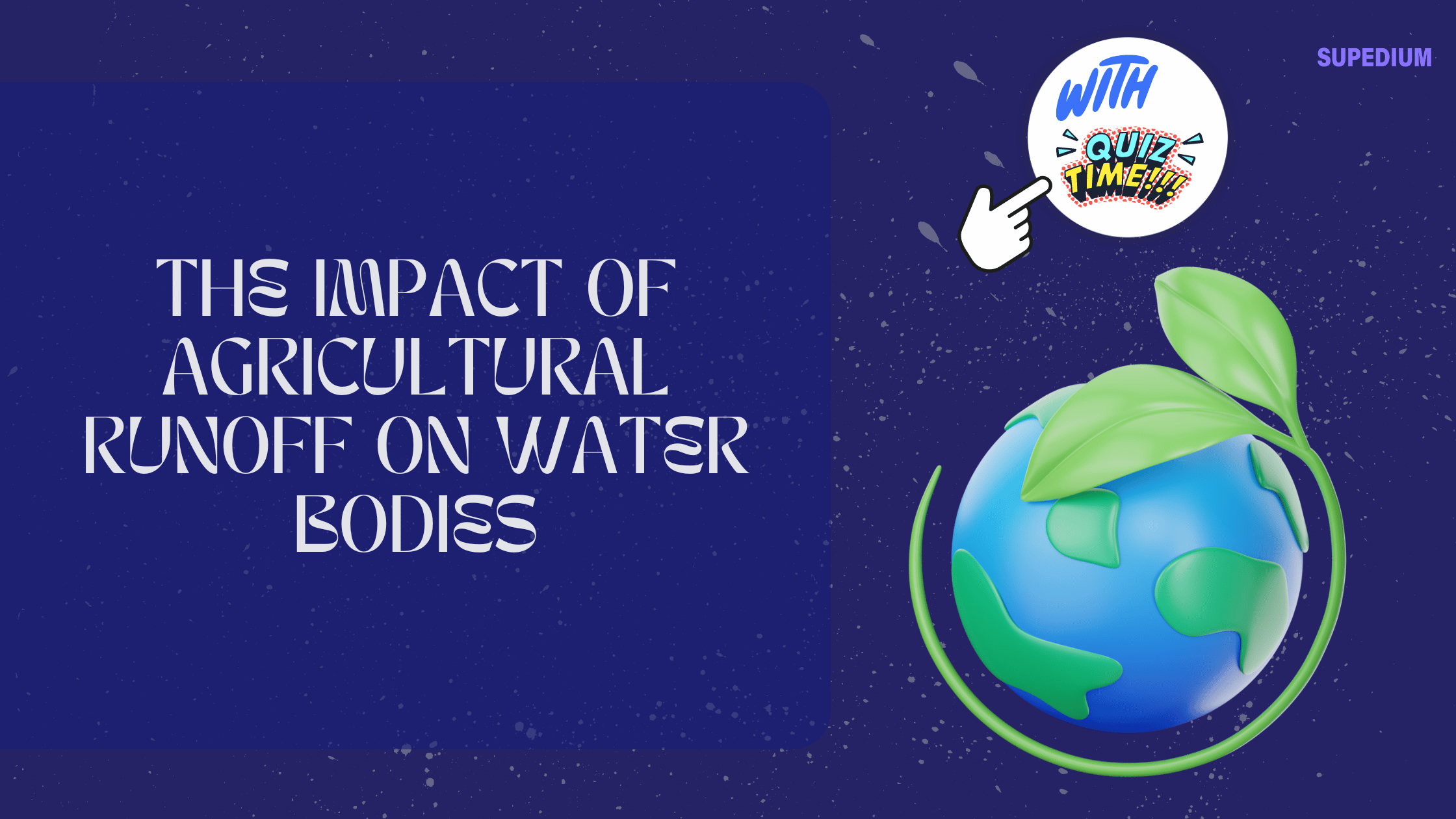Table of Contents
![]()
Agricultural runoff, the flow of water from farms carrying nutrients, pesticides, and other pollutants into water bodies, is a significant environmental issue. This article explores the causes of agricultural runoff, its environmental and human health impacts, mitigation strategies, and future directions.
Causes of Agricultural Runoff
Fertilizers
Fertilizers, especially those high in nitrogen and phosphorus, are a major source of agricultural runoff. These substances are applied to crops to enhance growth, but when used excessively, they can leach into nearby water bodies. Runoff carrying these nutrients contributes to nutrient pollution in streams, rivers, and lakes.
Mechanisms of Runoff:
- Surface Runoff: When rainfall or irrigation exceeds the absorption capacity of the soil, excess water flows over the land surface.
- Leaching: Nutrients can percolate through the soil and reach groundwater, which eventually flows into surface water bodies.
Excessive fertilizer application can lead to nutrient imbalances and increase the potential for runoff.
Pesticides
Pesticides, including herbicides and insecticides, are used to control pests and weeds. However, these chemicals can also be transported into water bodies through runoff. The overuse and improper application of pesticides exacerbate this problem.
Runoff Pathways:
- Drift: Pesticides can be carried by wind to nearby water bodies.
- Erosion: Pesticides can be attached to soil particles that are washed away by rainfall.
Pesticide runoff can lead to contamination of aquatic environments and disrupt ecosystems.
Soil Erosion
Agricultural practices, such as tilling and deforestation, contribute to soil erosion. Eroded soil is often carried into water bodies by runoff, leading to sedimentation.
Effects on Sediment Transport:
- Increased Turbidity: High sediment levels can reduce water clarity.
- Habitat Destruction: Sediment accumulation can smother aquatic habitats and disrupt food chains.
Livestock Waste
Livestock waste, including manure and urine, can be a significant contributor to runoff. When not properly managed, it can be washed into water bodies, carrying pathogens, nutrients, and organic matter.
Pathways to Water Bodies:
- Direct Runoff: Waste can be directly washed into water bodies during rainfall.
- Soil Absorption: Waste can seep through the soil and reach groundwater.
Environmental Impacts
Eutrophication
Eutrophication is the process by which water bodies become overly enriched with nutrients, leading to excessive growth of algae and other aquatic plants.
Effects on Aquatic Life:
- Algal Blooms: High nutrient levels can cause harmful algal blooms that produce toxins.
- Oxygen Depletion: Algae die and decompose, consuming oxygen and creating hypoxic conditions, which can kill fish and other aquatic organisms.
Case Studies:
- The Dead Zone in the Gulf of Mexico: Excessive nitrogen runoff from agriculture has created a large hypoxic zone in the Gulf, severely affecting marine life.
Water Quality Degradation
Agricultural runoff can lead to the contamination of water bodies with nutrients and chemicals.
Impact on Drinking Water Sources:
- Nitrate Contamination: High levels of nitrates can make water unsafe for drinking, particularly for infants.
- Pesticide Residues: Persistent organic pollutants can affect water quality and pose health risks.
Impact on Biodiversity:
- Species Loss: Changes in water quality can lead to a decline in species diversity and alter ecosystem functions.
Alteration of Aquatic Ecosystems
Runoff-induced changes can significantly alter aquatic ecosystems.
Changes in Species Composition:
- Invasive Species: Altered nutrient levels can favor certain species over others, disrupting native communities.
- Food Chain Disruption: Altered ecosystems can impact predator-prey relationships and overall ecosystem health.
Soil and Sediment Accumulation:
- Riverbed and Lake Bottom Changes: Sediment accumulation can alter water flow and reduce habitat quality for aquatic organisms.
Human Health Implications
Drinking Water Contamination
Agricultural runoff can lead to contamination of drinking water supplies.
Nitrate Levels and Health Risks:
- Methemoglobinemia: High nitrate levels can cause “blue baby syndrome,” a condition that reduces the ability of blood to carry oxygen.
Pesticide Residues and Chronic Health Effects:
- Cancer Risks: Some pesticides are associated with increased cancer risks and other health issues.
Recreational Water Use
Contaminated water can pose risks to recreational activities.
Health Risks from Algal Toxins:
- Microcystins: Produced by harmful algal blooms, these toxins can cause gastrointestinal and liver problems.
Impact on Swimming and Fishing:
- Health Advisories: Water bodies affected by runoff often have restrictions or advisories for recreational use.
Economic Costs
The economic impact of agricultural runoff is significant.
Costs of Water Treatment:
- Infrastructure Investments: Increased treatment requirements can lead to higher costs for water utilities.
Economic Impact on Fisheries and Tourism:
- Decline in Fisheries: Reduced water quality can affect fish populations and local fisheries.
- Tourism Losses: Polluted water bodies can deter tourists and impact local economies.
Mitigation Strategies
Best Management Practices (BMPs)
Implementing BMPs can reduce the impact of agricultural runoff.
Nutrient Management:
- Precision Agriculture: Tailoring fertilizer application to crop needs reduces excess runoff.
- Reduced Application: Applying only the necessary amount of fertilizers minimizes runoff.
Erosion Control:
- Cover Crops: Planting cover crops helps to stabilize soil and reduce erosion.
- Buffer Strips: Vegetated areas along water bodies can trap sediment and nutrients.
Integrated Pest Management (IPM):
- Pest Monitoring: Using pest monitoring and thresholds to minimize pesticide use.
- Alternative Control Methods: Incorporating biological and cultural controls to reduce reliance on chemical pesticides.
Policy and Regulation
Regulations play a crucial role in managing agricultural runoff.
Existing Regulations:
- Clean Water Act: Governs water pollution and sets standards for water quality.
- Nutrient Management Plans: Required for certain agricultural operations to manage nutrient application.
Enforcement and Compliance:
- Monitoring Programs: Regular monitoring ensures compliance with water quality standards.
- Penalties for Non-Compliance: Enforcing penalties for violations encourages adherence to regulations.
Incentives for Farmers:
- Subsidies for Sustainable Practices: Financial incentives support the adoption of BMPs and sustainable practices.
Technological Innovations
Technological advancements offer new solutions for runoff management.
Monitoring and Assessment:
- Remote Sensing: Satellite and drone technology for monitoring land use and runoff.
- Water Quality Sensors: Real-time sensors for tracking pollutant levels in water bodies.
Environmentally Friendly Products:
- New Fertilizers and Pesticides: Development of slow-release fertilizers and reduced-risk pesticides.
Community and Educational Efforts
Public awareness and education are vital for managing agricultural runoff.
Public Awareness Campaigns:
- Educational Materials: Campaigns to inform the public about the impact of runoff and ways to mitigate it.
Farmer Education Programs:
- Workshops and Training: Providing farmers with knowledge on best practices and technologies.
Collaboration Between Stakeholders:
- NGOs and Government Agencies: Partnerships to develop and implement effective runoff management strategies.
Case Studies
Positive Examples
Successful Runoff Management:
- Specific Farms or Regions: Case studies where BMPs have been effectively implemented, resulting in improved water quality and ecosystem health.
Impact Assessments:
- Positive Outcomes: Demonstrating the benefits of sustainable practices and reduced runoff.
Negative Examples
High-Profile Incidents:
- Water Pollution Events: Analysis of significant pollution events caused by agricultural runoff.
Lessons Learned:
- Failed Mitigation Efforts: Understanding the shortcomings and improving future strategies.
Future Directions
Research Needs
Identifying gaps in current knowledge can guide future research.
Gaps in Knowledge:
- Long-Term Effects: Research on the long-term impacts of runoff on ecosystems and human health.
Emerging Issues:
- Climate Change: Studying how changing climate patterns affect runoff and water quality.
Potential Innovations
Exploring new technologies and practices offers opportunities for better management.
New Technologies:
- Advanced Monitoring Tools: Innovations in tracking and managing runoff.
Interdisciplinary Approaches:
- Collaborative Solutions: Integrating insights from various fields to address runoff challenges.
Long-Term Goals
Setting goals for sustainable agriculture and global cooperation.
Sustainable Agricultural Practices:
- Adopting BMPs Worldwide: Promoting practices that minimize runoff and protect water resources.
Global Cooperation:
- Policy Development: Working together internationally to create and enforce effective policies.
Conclusion
Agricultural runoff has far-reaching impacts on water bodies, affecting environmental health, water quality, and human well-being. Addressing this issue requires a multifaceted approach, including the adoption of best management practices, effective regulation, and continued research and innovation. By working collaboratively, we can mitigate the effects of agricultural runoff and safeguard our water resources for future generations.






Be the first to comment